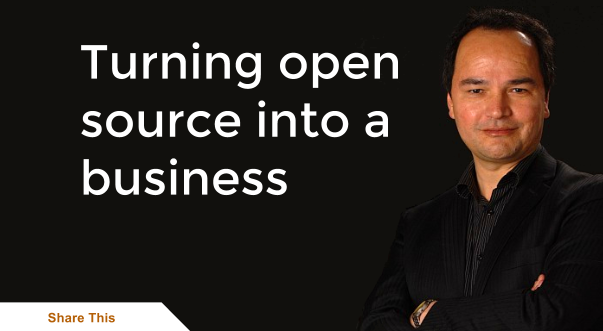Blog
Turning Open Source into a business

My Palmerston North Linux Users Group asked me if I could explain how I turned open source technology into my business. I didn't plan it that way, the opportunities just presented themselves. I thought the best way to explain it would be to illustrate the opportunities that arose.
Web Design back in 1998
To help fund myself through University I ran a small graphic design business where I made newspaper ads, interactive CDROMs and 3D animations using commercial software like Corel Draw, Authorware and TrueSpace. This is when the Internet first started taking off in New Zealand and I got interested in web design. Back in those days there wasn't any good web design software so I had to learn how to write Hypertext Mark-up Language (HTML) to create websites. HTML was my first introduction to Open Source and provided many opportunities to design websites because other graphic designers weren't learning it. Whilst at University I achieved the following because of HTML:
- Designed New Zealand's first online University Course (Silicon Soils).
- Formed my first web company (NZMADE) which designed New Zealand's first e-commerce website (EZIBUY).
- Created websites for many companies and moved NZMADE to Auckland when I graduated.
Here's an example of what NZMADE looked like back in 1998. The leading Open Source tecnologies that it used at the time were Javascript, streaming audio, DHTML and Frames:

Here's what Telecom (now Spark) looked like:

Some important lessons I learnt from that experience:
- Open Source technologies like HTML are on the "bleeding edge" which means they are testing boundaries before they come into use by everyone else. By learning them first you create skills for yourself that are in demand and valuable to others. We're still doing it now by learning things like responsive design, bootstrap, jquery, etc.
- Open Source introduced me to a whole new way of self learning based on Blogs, Howtos, FAQs, Forums and Groups. This way of learning has been far more important in my career than my degree.
The Big OE
In 2000 I sold NZMADE and travelled the World. I ended up in London and needed some work. I thought, "How can I make some money?" It just so happened that the Internet Cafe I was in was painfully slow because they had over 20 computers connected to a 128 Kbit ISDN connection. I approached the guy at the counter and said "I can fix the slowness issues you're having by installing a proxy and configuring your network properly." He didn't know what a proxy was but liked the idea of not getting complaints from his customers so arranged a meeting with his boss. I ended up getting my first overseas contract at that cafe by installing an open source proxy that I'd used back in New Zealand and reconfiguring their network. The lessons learnt from that exercise were:
- Playing with Open Source technologies like web servers, proxies and networking gives you skills and insight that many people need and will pay for.
- Many computing problems can be solved using free open source software that a lot of companies pay thousands for in non-free software.
The United States
After the UK I moved to Golden Valley, Arizona where my Sister and I started the US side of Spinning Planet. Previously I'd hosted my clients' websites with hosting companies but I decided that I wanted to do my own web hosting and manage my own servers because it gave me more profit and opportunities. However, it meant that I had to learn how to administer a Linux server and it took me at least 5 years to become competent at it - in that time I'd contract specialists and get favours from friends to help me out. However, learning those skills has lead to many benefits such as:
- I can now setup a fully functional server with mail, web, IDS, firewalls, DNS, automation and a lot more in two hours.
- My skills have allowed me to contract my services overseas for literally hundreds of thousands of dollars.
- I can now implement new features into our websites that many of our competitors have no idea exist because they don't understand how web servers actually work and what is available.
The lessons learnt from this experience were:
- Open Source was no longer just an option; it was now the defining path for anything I did.
- The more I got into Open Source the more opportunities that arose.
- I couldn't know everything Open Source so I specialised in technologies just to do with the web.
Back to New Zealand
 I returned back to New Zealand after September 11th escorted by 3 fighter jets out of Las Vegas, greeted by tanks and soldiers at LAX and arrived to an anthrax scare in Auckland. After a couple of years, and once I had staff, I used Open Source in the following ways in my company:
I returned back to New Zealand after September 11th escorted by 3 fighter jets out of Las Vegas, greeted by tanks and soldiers at LAX and arrived to an anthrax scare in Auckland. After a couple of years, and once I had staff, I used Open Source in the following ways in my company:- Started using the Open Source E107 Content Management system for all of my clients websites. They get the system for free that allows them to update their websites and we provide the hosting and ongoing support at a reasonable fee.
- We were using multiple Operating Systems for servers and desktops such as Windows, BSD, OSX, Debian, Centos and Fedora. To simplify things I moved all the servers and many of the desktops to Fedora and only used OSX for the designers. You can read my blog about it here.
- Created my own "Spin" of Fedora called Brynux that anyone can download for free.
Insights I gained from this experience are:
- I saved thousands of dollars not having to buy software or licences.
- Gained loads of time not having to fix Windows machines that would get "blue screens of death" or viruses.
- Once I learnt the Open Source versions of software (like Inkscape verses Corel Draw or Illustrator) I ended up liking the free Open Source software better because it offered more freedom and interoperability. As an example, take a look at what you can do with the GNU Image Manipulation in linux here.
Conclusion
There are many other examples I could give but really what I'm trying to show you in this blog is that Open Source isn't a lesser, insecure or disorganised solution that geeks might use. It's actually the most powerful resource for entrepreneurs, developers, designers and businesses because it provides opportunities beyond those restraints imposed by corporates wanting you to only use their proprietary digital ecosystems such as Macintosh or Microsoft.
If you found this blog helpful please share.
brynn :-)
 About
About
Brynn


